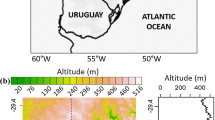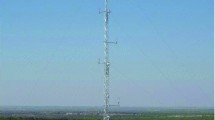Abstract
The Quiberon 2006 experiment was launched to document the onset and development of land and sea breezes over a semi-circular coastal bay propitious to inshore sailing competitions. The measurements were taken during the 2 weeks of 16–28 June 2006. Micrometeorological variables were recorded at three shore sites around the bay using turbulence sensors on 10–30-m high masts, on four instrumented catamarans at selected sites within the bay, and at a fourth shore site with a Sodar. Synoptic data and local measurements are analyzed here from the point of view of both micrometeorologists and competition skippers, testing in particular the empirical rules of breeze veering and backing according to the wind direction with respect to the coastline orientation at the mesoscale (the quadrant theory). Our analysis focuses on the patterns of lower-altitude wind direction and speed around the bay and over the water basin, and the temporal variations during the periods of the breeze onset, establishment and thermal reinforcement. In offshore synoptic-flow conditions (quadrants 1 and 2), the clockwise rotation of the surface flow had a very large amplitude, reaching up to 360\(^{\circ }\). The breeze strength was negatively correlated to that of the synoptic wind speed. In conditions of onshore synoptic flow from the west (quadrant 3) at an angle to the mainland coast but perpendicular to the Quiberon peninsula, the rotation of the flow was backwards in the early morning and clockwise during the day with a moderate amplitude (40\(^{\circ }\)–50\(^{\circ }\)) around the synoptic wind direction. As the surface wind speed was much larger than the synoptic wind speed, such a case we have designated as a “synoptic breeze”. The breeze onset was shown to fail several times under the influence of weak non-thermal events, e.g., the passage of an occluded front or clouds or an excess of convection. Finally, several local-scale influences of the complex coastal shape appeared in our measurements, e.g., wind fanning in the lee of the isthmus and airflow skirting around the peninsula forehand.

(adapted from Houghton and Campbell 2005)










Similar content being viewed by others
References
Abbs DJ (1986) Sea-breeze interactions along a concave coastline in Southern Australia: observations and numerical modeling study. Mon Weather Rev 114:831–848
Adams E (1997) Four ways to win the sea breeze game, Sailing World, March, pp 44–49
Arrit RW (1989) Numerical modelling of the offshore extent of sea breezes. Q J R Meteorol Soc 115:547–570
Arrit RW (1993) Effects of large-scale flow on characteristic features of the sea breeze. J Appl Meteorol 32:116–125
Barré S, Calmet I, Herlédant O, Iachkine P, Kobus JM, Mestayer PG, De Nomazy C, Piquet T, Quillard O, Rosant JM (2007) The Quiberon 2006 experiment: description and first results on the sea-breeze local behavior, Preprints, 7th conference on coastal atmospheric and oceanic prediction and processes, San Diego CA, USA, 10–13 Sept. 2007, Amer Meteorol Soc, P15.1, p 5
Bernot JY (2007) Météo locale: croisière et régate (in French), Gallimard/FFV (Fédération française de voile), Paris, France (ISBN : 978-2-7424-1944-9)
Biggs WG, Graves ME (1962) A lake breeze index. J Appl Meteorol 1:474–480
Boybeyi Z, Raman S (1992) A three-dimensional numerical sensitivity study of mesoscale circulations induced by circular lakes. Meteorol Atmos Phys 49:19–41
Caesar J (51 BC) De Bello Gallico 3.11–3.16 (Caesar’s Commentaries on the Gallic and Civil Wars, Electronic Text Center, University of Virginia Library, http://etext.virginia.edu/toc/modeng/public/CaeComm.html)
Calmet I, Mestayer PG (2016) Study of the thermal internal boundary layer during sea-breeze events in the complex coastal area of Marseille. Theor Appl Climatol 123:801–826. doi:10.1007/s00704-015-1394-1
Calmet I, Mestayer PG, van Eijk AMJ, Herlédant O (2017) A coastal bay summer breeze study, part 2: high-resolution numerical simulation of sea breeze local influences. Boundary-Layer Meteorol (this issue)
Crosman ET, Horel JD (2010) Sea and lake breezes: a review of numerical studies. Boundary-Layer Meteorol 137:1–29
Drouin N (2006) Campagne de mesures dans la baie de Quiberon, Master 1 report (in French), Univ Paris-Sud 11, France, p 39
Gilliam RC, Raman S, Niyogi DDS (2004) Observational and numerical study on the influence of large-scale flow direction and coastline shape on sea-breeze evolution. Boundary-Layer Meteorol 111:275–300
Herlédant O (2011) Étude numérique et expérimentale de la micro-météorologie des sites de régates côtières appliquée à la baie de Quiberon, Doctoral Thesis (in French), Ecole Centrale de Nantes, France, p 218 (https://tel.archives-ouvertes.fr/LHEEA/tel-00980030v1)
Houghton D, Campbell F (2005) Wind strategy, 3rd edn. Wiley, London 128 pp
Kusuda M, Alpert P (1983) Anti-clockwise rotation of the wind hodograph, Part I: theoretical study. J Atmos Sci 40:487–499
Lemonsu A, Bastin S, Masson V, Drobinsky P (2006) Vertical structure of the urban boundary layer over Marseille under sea-breeze conditions. Boundary-Layer Meteorol 118:477–701
Leroyer S, Calmet I, Mestayer P (2010) Urban boundary layer simulations of sea-breeze over Marseille during the ESCOMPTE experiment. Int J Environ Pollut 40:109–122
McPherson RD (1970) A numerical study of the effect of a coastal irregularity on the sea breeze. J Appl Meteorol 9:767–777
McLynn F (2011) 1759: the year Britain became master of the world. Random House, New York, pp 354–387
Mestayer PG, Durand P, Augustin P, Bastin S, Monnefond J-M, Bénech B, Campistron B, Coppalle A, Delbarre H, Dousset B, Drobinski P, Druilhet A, Fréjafon E, Grimmond CSB, Groleau D, Irvine M, Kergomard C, Kermadi S, Lagouarde J-P, Lemonsu A, Lohou F, Long N, Masson V, Moppert C, Noilhan J, Offerle B, Oke TR, Pigeon G, Puygrenier V, Roberts S, Rosant J-M, Sanïd F, Salmond J, Talbaut M, Voogt J (2005) The urban boundary-layer field campaign in Marseille (UBL/CLU-Escompte): set-up and first results. Boundary-Layer Meteorol 114:315–365
Miller STK, Keim BD, Talbot RW, Mao H (2003) Sea-breeze: structure, forecasting and impacts. Rev Geophys 41:1-1–1-31
Schröter JS, Moene AF, Holtslag AAM (2013) Convective boundary layer wind dynamics and inertial oscillations: the influence of surface stress. Q J R Meteorol Soc 139:1694–1711
Shibuya R, Sato K, Nakanishi M (2014) Diurnal wind cycles forcing inertial oscillations: A latitude-dependent resonance phenomenon. J Atmos Sci 71:767–781. doi:10.1175/JAS-D-13-0124.1
Steele CJ, Dorling SR, von Glasow R, Bacon J (2013) Idealized WRF model sensitivity simulations of sea breeze types and their effects on offshore windfields. Atmos Chem Phys 13:443–461
Steyn DG, Kallos G (1992) A study of the dynamics of hodograph rotation in the sea breezes of Attica, Greece. Boundary-Layer Meteorol 58:215–228
Triplet JP, Roche, G (1986) Météorologie générale (in French), Ecole Nationale de la Meteorologie – Météo France, p 317
Zilitinkevich SS (1989) Velocity profiles, the resistance law and the dissipation rate of mean flow kinetic energy in a neutrally and stably stratified planetary boundary layer. Boundary-Layer Meteorol 46:367–387
Acknowledgements
We gratefully acknowledge the help of Météo France forecasters at the local stations (Vannes, Lorient) and the regional centre in Rennes, as well as of the scientists of CSTB-Nantes for the use of their sodar. We thank the Quiberon National Sailing School (Ecole Nationale de Voile et de Sports Nautiques), the Saint Philibert sailing club (Ecole de Voile Océane), and the municipality of Saint-Pierre Quiberon for their warm hospitality and logistic support. Special thanks go to Jean-Michel Kobus for his role in the project organization, to Nicolas Drouin, Claire De Nomazy and Paul Iachkine for their participation in the experimental campaign, to Alexander (Lex) van Eijk for his careful proofreading, and to an unknown reviewer for numerous positive recommendations. We will not forget Olivier Quillard, who recently passed away. The synoptic data were issued from the “surface analyses France North-West” of Meteo France (http://meteocentre.com/analysis/map-surface.php?, accessed on 4 May 2017). The background of Fig. 2a is a map from Géoportail and that of Fig 2b originates from the French national hydrographical service. Trade names and companies are given for the benefit of the reader and do not imply any endorsement of the product or company by the authors.
Author information
Authors and Affiliations
Corresponding author
Rights and permissions
About this article
Cite this article
Mestayer, P.G., Calmet, I., Herlédant, O. et al. A Coastal Bay Summer Breeze Study, Part 1: Results of the Quiberon 2006 Experimental Campaign. Boundary-Layer Meteorol 167, 1–26 (2018). https://doi.org/10.1007/s10546-017-0314-6
Received:
Accepted:
Published:
Issue Date:
DOI: https://doi.org/10.1007/s10546-017-0314-6




